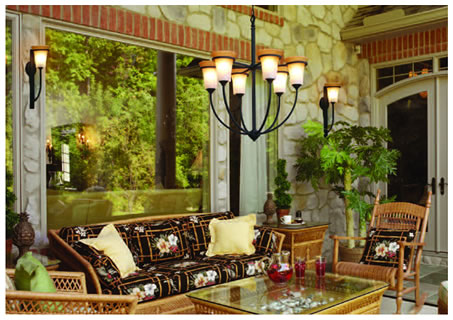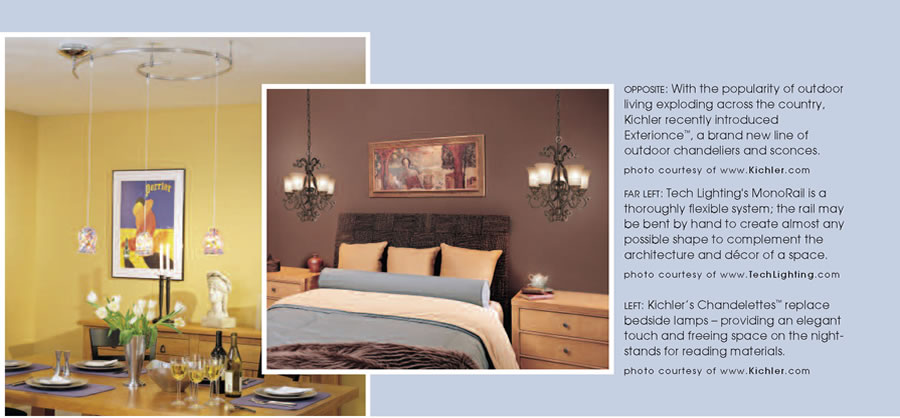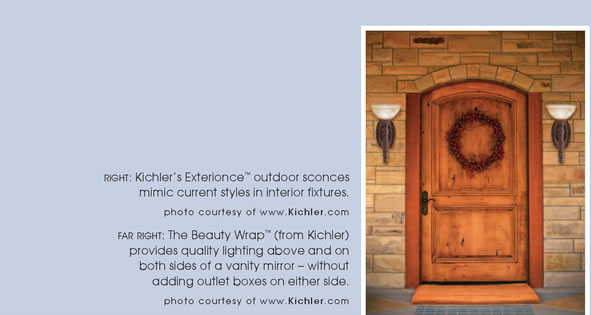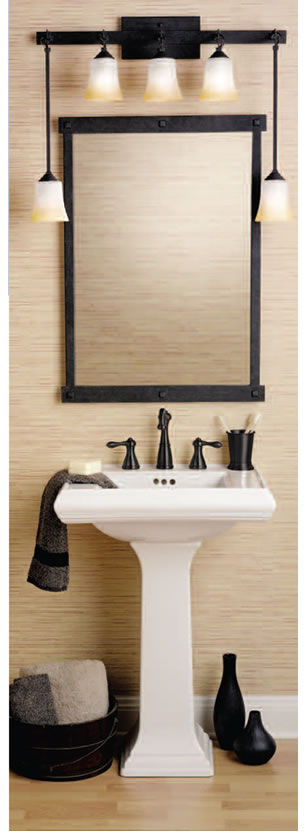Transform Your Home with Lighting Design
 Next to new wall color, nothing changes a room’s appearance more dramatically than lighting. And today’s homeowners have more ways to transform their homes with light than ever before.
Next to new wall color, nothing changes a room’s appearance more dramatically than lighting. And today’s homeowners have more ways to transform their homes with light than ever before.
Layering light remains the most pervasive trend, notes Jeffrey Dross, product manager for Kichler Lighting. “Take the kitchen, for example. Previously, it often had a single lighting fixture in the middle of the ceiling. Today, there’s under-cabinet lighting, above cabinet lighting, inside-cabinet lighting, pendants over the island, a chandelier over the table, rope lighting in the toe kick and recessed lights wherever needed.” Two of the hottest fixtures creating extra layers of light are chandeliers and sconces.
Chandeliers“Chandeliers are adding a little luxury to unexpected areas of the home,” says Dross.“ In fact, I’ve seen a chandelier in every room I can think of except the laundry room. To accommodate these different uses, chandeliers are now available in more sizes.
“Kichler makes 15 miniature chandeliers called Chandelettes™. They match traditional, full-size families of fixtures, have a single tier and are around 16 inches in diameter. Two or three of these mini chandeliers can light the length of a dining room table– instead of merely illuminating the center of the table with a single chandelier. I’ve seen people put a row of them in a hallway or use a pair on either side of a bed or flanking a vanity mirror. Their demure height also makes them a viable option for rooms with 8- foot ceilings.
“With today’s volume ceilings, companies are adding chandeliers taller than the conventional 25- to 30-inch height. We are including 36-, 49- and even up to 57-inch chandeliers that fit comfortably in a 2-story foyer.”
David Kane, a lighting consultant for United Lighting Design, and Laurie Claxton, a lighting consultant for The Light Palace, both divisions of United Electric Supply in Omaha, Nebraska, also note the boom in chandeliers. “When people hear the word ‘chandelier,’ they may picture an ornate, tiered fixture with crystal baubles,” remarks Kane, “but it actually applies to any pendant with arms and runs the whole gamut– including clean, contemporary looks and simple fixtures with glass shades.

“Today’s chandeliers often mix traditional elements with contemporary materials,” Kane continues. “Fixtures with alabaster and satin nickel are quite popular. Even in contemporary approaches, using a satin or brushed nickel instead of chrome tones down what might otherwise look high tech and makes it warmer. Plus, it becomes more transitional, allowing it to blend with more styles.“Today’s chandeliers often mix traditional elements with contemporary materials,” Kane continues. “Fixtures with alabaster and satin nickel are quite popular. Even in contemporary approaches, using a satin or brushed nickel instead of chrome tones down what might otherwise look high tech and makes it warmer. Plus, it becomes more transitional, allowing it to blend with more styles.
“There are also more choices in glass. Not only can you choose from clear or milk white glass, but now white alabaster and cream alabaster have made a comeback, along with toned and colored glass, giving you the color options of amber, blue, red and more. Italian and European glass are prevalent, with an emphasis on an old style called Scavo. Scavo glass has a noticeable texture on the outside and looks like it has been sandblasted.”
“Colored crystal is also new,” adds Claxton.“Bernard Picasso and Schoenbeck have come out with fixtures with blue, green and red crystals. I recently included a pink chandelier in a young girl’s bedroom.
“Tiffany glass is making a huge comeback,” Claxton continues. “And it’s higher quality than much of it from the 80’s, with heavy leading and thick glass. Quoizel and Meyda Tiffany are two of the prominent manufacturers right now.”
"Sconces are enjoying renewed popularity,” notes Dross, “combined with a chandelier in a foyer, creating umbrellas of light in a hallway, adding ambience in the dining room, flanking a bathroom mirror or a fireplace in the great room. Like chandeliers, sconces have grown to accommodate volume ceilings. Five years ago, most sconces were eight inches high. Today, we have sconces that are 20 inches and 32 inches.
“Even so, it’s important to place sconces appropriately to fill expansive vertical spaces. Sconces can be located from 60 to 72 inches from the floor. In ten- to twelve-foot ceiling areas, or great rooms with twice that height, they may be most attractive at heights over 72 inches.”
“In the high-end homes we’re designing ($350,000+), I’m seeing a trend toward more well-designed, well-placed recessed lighting and a few decorative fixtures to tie a design or theme together,” says Kane. “Standard downlighting utilizes 5-inch or 6-inch diameter cans. Three- and 4-inch diameter cans are used for specialty and accent lighting.”
Rail Lighting Systems
For a more high-tech feel, a bendable rail lighting system can give track lighting a fresh look. Suspended, rather than mounted flush to the ceiling, a rail system allows the designers to create a continuous and flowing design with the rail itself, making it another element of the overall design. By using heads or pendants with matching glass and metal finishes, the rail can repeat a design or motif used elsewhere in the home.
The rail systems are easy to work with and allow the designer a wide variety of creative options. “I’ve even created a circle with the rail and suspended pendants above a table,” says Kane. “It’s a fresh alternative to a chandelier.”
More attention is being paid to light quality as well. “In recent years, many homeowners made do with a light strip above their vanity because that’s where the electrician put the outlet box during the home’s construction,” Dross recalls. “Overhead lights by themselves produce glare and shadows, but most homeowners were reluctant to spend the money for rewiring. Now, Kichler offers an accessory kit so they can swag pendants or mini chandeliers from the outlet box (some weight and diameter restrictions apply). Or they may consider one of our new products called the Beauty Wrap™. Mounted from the box in the center, it provides lights both above and on either side of the mirror.”
Today’s homeowners are finding considerably more green choices in lighting fixtures. “This is one of my pet areas,” Dross comments. “I’ve put together a line of 104 energy efficient fixtures, and my goal was to make them so attractive and interesting that people would be surprised to learn they were fluorescent. And, of course, the color of fluorescent bulbs has improved greatly over the years. To find a fluorescent bulb that looks like an incandescent, look for one with a color rendering index (CRI) in the high 70’s to mid 80’s and a Kelvin temperature around 2700. Energy-conscious homeowners are also switching recessed lights from incandescent to fluorescent.”

LED Lighting
“In addition to retrofit compact fluorescent lamps that look like regular household bulbs, LED light sources (light emitting diodes) offer great energy savings,” notes Kane. “For example, 18 LEDs draw less than 3 watts. As an added benefit, they usually have a 60,000 – 100,000 hour lamp life. That means if you use an LED light in your stairwell, you could leave it on, night and day, and it would still last 111/2 years. LEDs are more expensive up front, but you save money in the long run.

“Because LED lights don’t get hot, they’re great for under-cabinet lamps. They’re also now available in rope lighting. I had a client who wanted to put rope lights on the edges of his steps. Standard rope lighting would burn the carpet over time, but that wasn’t a concern with the LED.” Dross says outdoor lighting is exploding. With outdoor living spaces tremendously popular throughout the country, it naturally follows that people are looking for beautiful, weatherproof fixtures to light them. Kichler has responded with a line of outdoor wall sconces that look like interior sconces, as well as a brand new line of outdoor chandeliers.
Kane has seen major changes in landscape and outdoor lighting in recent years as well. “In the 80’s, all we had were black landscape lights that were meant to be hidden and a few choices of outdoor finishes,” he recalls. “Today, there are so many more fixture choices and finish options available. The outdoor fixture is part of the overall design.
“Powder coat paint finishes are now available. Because the powder is electrostatically charged to the metal, they’re more durable. They also provide greater texture options and a wide range of colors.
“LED light are great outdoors because they’re inexpensive to run and because they can take the elements; it doesn’t matter if it’s hot or cold. There are already LED lights for under-water pond lighting, deck posts and steps. I expect to see many more options in the near future.
Brushed nickel is still the number one finish according to Dross. “I think it has hit its peak,” he remarks, “but the peak is so darn high, it will take a long time for it to taper down. Folks will still be very comfortable using it in their homes. I’d say bronze and metallic finishes are the rising colors. There is still a large demand for detailed, painted brown tone finishes (which often consist of as many as five separate color applications). A darkened copper color is emerging that looks fabulous with cherry woods and pretty nice with mahogany.
“We have a burnished, antique brass finish that’s very popular. Shiny brass is currently out unless you’re buying a classic Williamsburg chandelier, but it’s bound to be back. Shiny brass will come and go and come and go because it fits so comfortably. And after all, there are only so many finishes.” Kane notes there are even more options when it comes to wall box dimmers, switch plates and receptacles. Lutron now offers 27 different colors and finishes!
With so many choices, homeowners may get overwhelmed making lighting decisions. Dross has two pieces of advice:“ (1) When in doubt, keep it simple. The more ornamentation you get, the more difficult it becomes to blend in your home and the more likely the fixture will become dated. (2) Use sales staff in lighting showrooms as resources. They make great sounding boards throughout the process. They work with lighting day in and day out. They know what’s popular and they know what works in different situations.”

